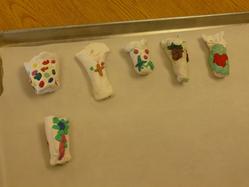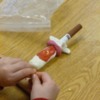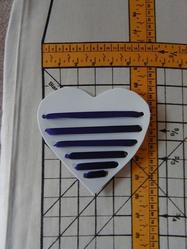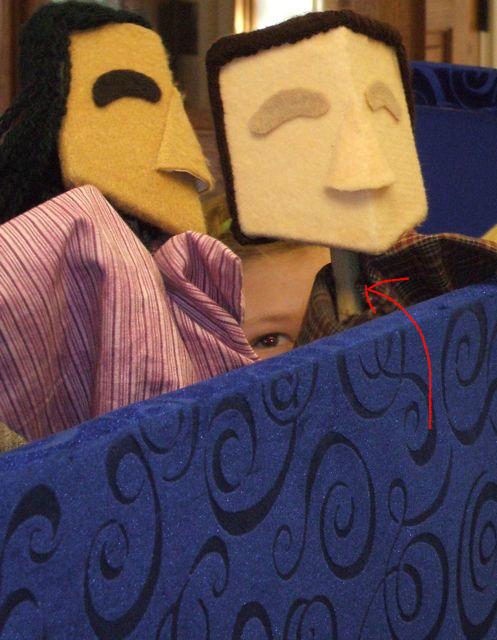The Greatest Commandment
Lesson Set
Overview of all workshops in this Rotation:
--for 4th-6th grade
- Creative Motion: Focus on learning the key Bible verse in an unusual way (using Body Sox)
- Games: Play games that teach learning to Love God with all you’ve got.
--for 1st- 3rd grade:
- Cooking: Make heart-shaped sugar cookies and share half of each cookie. Talk about loving your neighbor as a way of showing love to God.
- Video: Watch a video on the Heifer project. Discuss loving God & neighbor.
-for all grades:
- Art: Make a clay mezuzah. Talk about the need to always remember to love God and to spread the love of the Lord to your neighbor.
This Set also include two "old" lessons used back in 2003 when we first did this rotation, but not used in 2008:
Scripture Reference:
Matthew 22: 34-40
Key Verse:
“Love the Lord your God with all your heart and with all your soul and with all your mind… love your neighbor as you love yourself.” Matthew 22:37,39 (NIV)
Rotation Objectives
--at the end of the Rotation, kids should be able to:
- Name that the story is found in the New Testament in the Gospels.
- Locate the story in the Bible. (For 3rd grade and up)
- Re-tell in his/her own words the story of Jesus giving the greatest commandment.
- Recognize that Jesus summarized the Ten Commandments into two, which emphasize love: love God with all you’ve got (your heart, soul, and mind) and love your neighbor as yourself.
- Express ways in which the church today (including the children) carries out Jesus’ commandment to love.
Notes about this Rotation:
This is our second time to do this Rotation (we are in year 7). When we did this Rotation the first time we had 5 groups of kids. Now we have 6 groups, so an additional workshop was needed. You’d think that I as the curriculum coordinator would just add a workshop to the 5 that already existed. No, I have to do things the hard way (though it’s worked out for the best this time). I ended up re-writing everything!
The art workshop we did this time was totally different. The original art workshop is still included here because it was good. I just had a different idea that I wanted to do. Also we did not repeat the drama workshop (it also is included here). It was an ok lesson I just wanted to do something with our body sox. Crazy? Yes, I am.
Story Background:
Last month kids learned about the Ten Commandments in the Old Testament. Now that we’ve asked kids to learn all ten, this month they’ll learn that Jesus summarized those ten into two! Together these two are known as the “greatest commandment” and their emphasis is on love. How is it that love sums up the Ten Commandments? How does this greatest love commandment speak to us today? Let’s embark on our study with the hope of teaching children what we learn.
God loved us first. The Bible tells us God’s love story with the human race. Open the Bible for numerous examples of God’s love. Remember how God loved the Israelites, and gave them the Ten Commandments so they’d know how to live? Remember how God loved us, so he sent us Jesus who died for our salvation? All these examples of God’s love teach us how to love in return. Let’s look at our Bible passage, Matthew 22: 34-40.
Putting this in context- what’s the setting/situation?
As Jesus travels about teaching and healing, there are many people who come to believe in him. But there are also religious leaders who are critical of his ministry. In particular were groups such as the Pharisees who were upset that Jesus and his disciples seemed to not follow Jewish law to the letter. They saw Jesus as a threat to their religious system. They challenged Jesus several times, over questions of the “law”. Their challenges became efforts in a sense to “trap” Jesus, to discredit him, to turn people away from him. Our Bible passage tells of one of these attempts at entrapment.
What is it about these Pharisees?
The Pharisees were a strict Jewish sect. They closely kept the laws of God, but to the extreme. Their tendency was to add on to God’s law, believing that their additional rules helped people keep the actual law of God. Instead, this essentially made the law very difficult to follow. For example: The Ten Commandments include number four: “Remember the Sabbath day by keeping it holy” (Exodus 20:8). The Sabbath was intended to be a day of rest, recreation and worship. Perhaps God knew we’d need rest and a time to focus on him; that this would help us to love and serve him. But there is the question: What does it really mean to “remember the Sabbath day?”
Over time, there came to be 39 major kinds of work prohibited on the Sabbath (Patterson, 78). This included walking more than 3/5’s of a mile or carrying any kind of load. Farming was not allowed – thus no spitting because that could create a furrow in the soil, and that would be farming. Walking on grass was another no-no for the Sabbath. The bruising of the grass was considered harvest work. The list went on and on.
Many Pharisees were godly men but tended to DESPISE those who didn't share their beliefs. They called such people “sinners.” The Pharisees were so caught up in the details of their man-made laws that they lost sight of the spirit of God’s law. It’s almost as if they forgot why they were following the laws in the first places. The Pharisees were upset that Jesus' disciples picked grain on the Sabbath and that Jesus healed someone on the Sabbath. Jesus frequently argued with the Pharisees, condemning their self-righteous behavior and their strict interpretations of the laws. Prior to our story, Jesus has already had run-ins with the Pharisees. (For a few examples in Matthew that come prior to our story, see 12:1-12 and 15:1-20).
Back to the Bible verse…and more questions
Hearing that Jesus had silenced the Sadducees, the Pharisees got together. One of them, an expert in the law, tested him with this question… (Matthew 22:34-35)
Who were the Sadducees?
Sadducees were another Jewish group during the time of Jesus. They weren’t quite as extreme as the Pharisees but shared with them, a hatred of Jesus. In the verses just prior to our story the Sadducees had also been testing Jesus with questions that were squashed by Jesus’ answers. (Matthew 16:1-3, 22:23-33)
Who was this “expert”?
We don’t know his name but he would have been a legal expert, a very sophisticated scholar schooled in interpreting the Jewish Torah (the first five books of the Old Testament, also called the Pentateuch, which included the Ten Commandments). This lawyer obviously has an underlying motive—to test Jesus, to see how he will answer a difficult theological question, to challenge Jesus on the law of the land. At Jesus’ time, there were hundreds and hundreds of commands in the law. This lawyer is thinking that if he can force Jesus to choose one command as the greatest, maybe he’ll leave out something important.
Wait a minute. This ‘law of the land’ stuff is confusing
Let’s back up to last month where our rotation focused on the Ten Commandments. God had brought his people safely out of slavery in Egypt. Once free, God gave the people his law; rules that would help the people know how to live; the rules we know as the Ten Commandments. We didn’t go into it with the kids, but there were also other God-given laws described in the book of Exodus – laws about dealing with property, justice, social and religious duties, and human rights. There are even instructions about how to celebrate feasts such as Passover. All of these were intended by God “to be a guide to good relationships – with God and with other people” (Alexander, 118). It was certainly necessary for Old Testament times. But by the time Jesus walked the Earth things had gotten pretty confusing. As mentioned, there were those who had forgotten the spirit of the law. It is to these people that Jesus speaks. But at the same time, his teaching is also directed towards more “ordinary folks” (and perhaps to us today). It’s about where to put our focus.
Today, all of these laws seem really confusing to us. How much of this ‘old’ law still applies? We can look to the New Testament for the answer. Jesus said:
“Do not think that I have come to abolish the law or the prophets; I have not come to abolish them but to fulfill them.” (Matthew 5:17)
When Jesus refers to the “law and the prophets” he is speaking of the law, the Torah, and the prophets, a major portion of the other writings of the Old Testament. So in a sense, Jesus is saying that he has not come to abolish the Old Testament. The word ‘fulfill’ here means to “fill with fuller meaning” (Alexander, 118). Jesus is not saying that we should reject God’s laws. What “fuller meaning” will they have? We are about to see how Jesus is going to simplify things.
Back to the Bible passage – how did Jesus respond?
“Teacher, which commandment in the law is the greatest?” He (Jesus) said to him, “You shall love the Lord your God with all your heart, and with all your soul, and with all your mind. This is the greatest and first commandment. And a second is like it, ‘You shall love your neighbor as yourself.’ On these two commandments hang all the law and the prophets.” (Matthew 22:36-40)
Jesus responded by summarizing the entire Ten Commandments into two major categories: Loving God and Loving Others. Surely Jesus surprised the Pharisees by answering with two commandments, but he makes it clear that these two cannot be separated. This had always been at the heart of the commandments, yet the Pharisees had missed the point.
Jesus was quoting the Old Testament
In his answer to the Pharisees, Jesus used words that weren’t his own creation; they were from the Old Testament. The first segment was a quotation from Deuteronomy 6:5 – “Love the LORD your God with all your heart and with all your soul and with all your strength.” The second portion was from Leviticus 19:18b – “Love your neighbor as yourself.”
Jesus often quoted what we know as the Old Testament. It shows that he really knew the Hebrew Bible! This connection to the Old Testament makes our Art workshop pertinent – taking an ancient art form and filling it with fuller meaning. The project will be to fashion a clay mezuzah (muh-ZOO-zuh). A mezuzah is a small, decorated container, which is attached to the doorframe of a Jewish home. This was a practice began by ancient Jews and continued today. Inside this container is placed a copy of what is called “the Shema.” The Shema includes Deuteronomy 6:5 – “Love the LORD your God with all your heart and with all your soul and with all your strength.” The purpose of having a mezuzah is to remind everyone as they pass through the doorway, that they are to love God and spread God’s love to friends and family.
A summary
The Ten Commandments that God gave the Israelites long ago still apply to us today (just ask any of the kids who were here last month!) But we also have them summarized by Jesus into a command to love. Being loved first by God and loving back in all the ways that are possible, with all we’ve got – our heart, soul, and mind. We are commanded to love our neighbor as we love ourselves.
How simple: Two commandments, --but really one:
Love.
Love God first.
By loving God first, one is empowered to love one’s neighbor.
One cannot love one’s neighbor, without loving God first
and
one cannot love God without seeking to share that love with others.
References:
- Alexander, Pat. The Lion Encyclopedia of the Bible. Lion Publishing, 1986.
- Desoto Presbyterian Church, Dallas, TX. “The Greatest Commandment: Thoughts On What We Want The Kids To Know.” 2001.
- Patterson, Bob. Discovering Matthew. Guideposts Books, 1985.
- Simmons, Shraga. “Shema Yisrael.” 1995-2008. https://www.aish.com/jl/m/pb/48954656.html
- Scripture quoted is taken from the HOLY BIBLE, NEW INTERNATIONAL VERSION®. Copyright © 1984 International Bible Society. Used by permission of Zondervan. All rights reserved.
A Lesson Set written by Carol Hulbert from: First United Methodist Church
Ann Arbor, MI
Copyright 2008 First United Methodist Church, Ann Arbor, MI.
Permission to copy materials granted for non-commercial use provided credit is given and all cited references remain with this material
A representative of Rotation.org reformatted this post to improve readability.

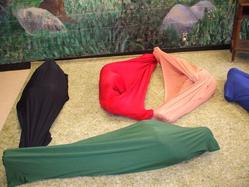 Form groups for the first two or three words (Love, the, Lord). Tell each group what word they will be performing. Encourage them to plan out how they will present this word – laying on the floor, or standing up? [Do this before passing out body sox!]
Form groups for the first two or three words (Love, the, Lord). Tell each group what word they will be performing. Encourage them to plan out how they will present this word – laying on the floor, or standing up? [Do this before passing out body sox!]
